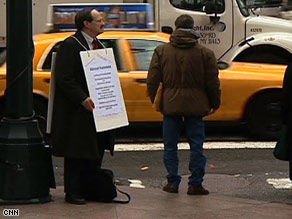
Friday's jobless numbers reporting an additional loss of 533,000 jobs for the month of November continues to pummel the stock market, and brings great concern on the state of the economy. While the current unemployment rate is at 6.7%, the real unemployment rate is most likely much higher, as it does not take into consideration those who have simply given up looking for work.
The unemployment rate has been made less meaningful by the long-term rise in dropouts from the labor force. The simple percentage of people without jobs — including retirees, stay-at-home parents and discouraged would-be job seekers — can also be misleading, though. It has dropped in recent decades mainly because of the influx of women into the work force, not because the job market is fundamentally healthier than it used to be.One person who has not, is Paul Nawrocki, who's taken to standing in the streets looking for work.
The Labor Department does publish an alternate measure of unemployment, which counts part-time workers who want full-time work, as well as anyone who has looked for work in the last year. (The official rate includes only people who told a government surveyor that they had looked in the last four weeks.)
This alternate measure rose to 12.5 percent in November. That is the highest level since the government began calculating the measure in 1994.
Perhaps the best historical measure of the job market, however, is the one set by the market itself: pay.
During the economic expansion that lasted from 2001 until December 2007, when the recession began, incomes for most households barely outpaced inflation. It was the weakest income growth in any expansion since World War II.
Paul Nawrocki says he's beyond the point where he cares about humiliation. That's why he weekly takes a 90-minute train ride to New York, where he walks the streets wearing a sandwich board that advertises his plight: The former toy-industry executive needs a job.This is just another example of the results of eight years of failed economic policies by the Bush Presidency and the Republican controlled Congress.
"Almost homeless," reads the sign. "Looking for employment. Very experienced operations and administration manager."
Wearing a suit and tie under the sign, Nawrocki -- who was in the toy industry 36 years before being laid off in February -- stands on Manhattan corners for hours, hoping to pass resumes to interested passers-by.
"When you're out of work and you face having nothing -- I mean, having no income -- pride doesn't mean anything," Nawrocki said. "You need to find work. I have to take care of my family."
Republicans may excel at telling lies and using Rove Style politics to get elected, but it's pretty clear that they fail at governing. It's been demonstrated that both the Stock market and the economy performs much better under a Democratic President, as opposed to a Republican President.
President Bush's multitrillion-dollar tax cuts, which were strongly tilted toward the rich, could not prevent (and may even have contributed to) significant job losses. On the other hand, when Bill Clinton raised taxes on affluent people to balance the federal budget (while significantly expanding the Earned Income Tax Credit for working poor people), unemployment declined substantially. Under Clinton's watch, 22 million jobs were created.Obama's inauguration can't come fast enough.
Prefer a broader historical comparison? In the past three decades, since the Organization of the Petroleum Exporting Countries oil price shocks of the mid-1970s and the Republican turn toward "supply side" economics, the average unemployment rate under Republican presidents has been 6.7 percent – substantially higher than the 5.5 percent average under Democratic presidents. (The official unemployment rate takes no account of people who have given up looking for work or taken substantial pay cuts to stay in the labor force.) Over an even broader time period, since the late 1940s, unemployment has averaged 4.8 percent under Democratic presidents but 6.3 percent – almost one-third higher – under Republican presidents.
Lower unemployment under Democratic presidents has contributed substantially to the real incomes of middle-class and working poor families. Job losses hurt everyone – not just those without work. In fact, every percentage point of unemployment has the effect of reducing middle-class income growth by about $300 per family per year. And the effects are long term, unlike the temporary boost in income from a stimulus check. Compounded over an eight-year period, a persistent one-point difference in unemployment is worth about $10,000 to a middle-class family. The dollar values are smaller for working poor families, but in relative terms their incomes are even more sensitive to unemployment. In contrast, income growth for affluent people is much more sensitive to inflation, which has been a perennial target of Republican economic policies.
